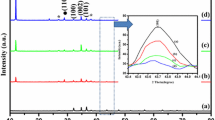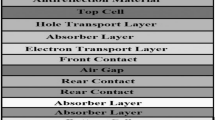Abstract
Photovoltaic (PV) performance of chemically synthesized indium-doped zinc oxide (IZO) nanorod electrodes has been investigated by photocurrent density-voltage (J-V). The indium (In) concentration was varied from 2 to 6 at.% for IZO. The J-V measurements as performed under a dark condition and a simulated white light of 80 mW/cm2 confirmed increase in PV performance with the IZO electrodes, making a peak with the 4 at.% In concentration. The investigated properties of the synthesized In-doped ZnO nanorod electrodes (structural and optical) strongly agreed with the PV results and well support the enhanced PV performance of the IZO electrodes. This clearly indicates that IZO electrodes would be preferred against undoped ones in PV solar cell application.

Graphical Abstract






Similar content being viewed by others
References
Shinde NM, Lokhande CD, Kim JH, Moon JH (2012) Low cost and large area novel chemical synthesis of Cu2ZnSnS4 (CZTS) thin films. J Photochem Photobiol A 235:14–20
Tyona MD, Jambure SB, Lokhande CD, Banpurkar AG, Osuji RU, Ezema FI (2018) Dye-sensitized solar cells based on Al-doped ZnO photoelectrodes sensitized with rhodamine. Mater Lett 220:281–284
Andrew B, Ngwe Z, Keith RM, Kean F (2013) High efficiency silicon solar cells. Energy Procedia 33:1–10
Jambure SB, Patil SJ, Deshpande AR, Lokhande CD (2014) A comparative study of physico-chemical properties of CBD and SILAR grown ZnO thin films. Mater Res Bull 49:420–425
de Souza Lucas FW, Zakutayev A (2018) Research Update: Emerging chalcostibite absorbers for thin-film solar cells. Apl Mater 6:084501–084509
Zong-Liang T, Chien-Hung C, Chun-Guey W (2015) Surface engineering of ZnO thin film for high efficiency planar perovskite solar cells. Sci Rep 5:13211–13219
Mukhamedshina D, Mit K, Chuchvaga N, Tokmoldin N (2017) Fabrication and study of sol-gel ZnO films for use in Si-based heterojunction photovoltaic devices. Mod Electron Mater 3:158–161
Babar H, Aasma A, Taj MK, Michael C, Bahman Z (2019) Electron affinity and bandgap optimization of zinc oxide for improved performance of ZnO/Si heterojunction solar cell using PC1D simulations. Electronics 8:238–246
Vladimirov M, Kühn TG, May F, Weitz RT (2018) Energy barriers at grain boundaries dominate charge carrier transport in an electron-conductive organic semiconductor. Sci Rep 8:14868–14878
Rau U, Taretto K, Siebentritt S (2009) Grain boundaries in Cu(In,Ga)(Se, S)2 thin-film solar cells. Appl Phys A Mater Sci Process 96:221–234
Tejas SS, Cristina M, Lidón GE, Ávila J, Michele S, Henk JB, Koster LJA (2017) Recombination in perovskite solar cells: significance of grain boundaries, interface traps, and defect ions. ACS Energy Lett 2:1214–1222
Yu X, Yu X, Zhang J, Zhang D, Chen L, Long Y (2017) Facile boosting light-scattering of ZnO nanorods in broadband spectrum region. Opt Mater 66:131–136
Tyona MD, Osuji RU, Lokhande CD, Ezema FI (2018) Photovoltaic properties of aluminum doped zinc oxide electrodes based on variation of aluminum impurities in the semiconductor. J Mater Phys Chem 6:9–16
Machado G, Guerra DN, Leinen D, Ramos-Barrado JR, Marotti RE, Dalchiele EA (2005) Indium doped zinc oxide thin films obtained by electrodeposition. Thin Solid Films 490:124–131
Biswal R, Maldonado A, Vega-Pérez J, Acosta DR, Olvera MDL (2014) Indium doped zinc oxide thin films deposited by ultrasonic chemical spray technique, starting from zinc acetylacetonate and indium chloride. Mater 7:5038–5046
Wen-Wu Z, Fa-Min L, Lu-Gang C, Xue-Quan L, Yi L (2011) Effect of growth time on the structure, Raman shift and photoluminescence of Al and Sb codoped ZnO nanorod ordered array thin films. Appl Surf Sci 257:9318–9322
Yu J, Yuan Z, Han S, Ma Z (2012) Size-selected growth of transparent well-aligned ZnO nanowire arrays. Nanoscale Res Lett 7:517–525
Wang H, Xie C (2006) Controlled fabrication of nanostructured ZnO particles and porous thin films via a modified chemical bath deposition method. J Cryst Growth 291:187–196
Tyona MD, Osuji RU, Asogwa PU, Jambure SB, Ezema FI (2017) Structural modification and band gap tailoring of zinc oxide thin films using copper impurities. J Solid State Electrochem 21:2629–2638
Hu Z, Jiao B, Zhang J, Zhang X, Zhao Y (2011) Indium-doped zinc oxide thin films as effective anodes of organic photovoltaic devices. Int J Photoenergy 2011:1–5
Kim MS, Yim KG, Kim S, Nam G, Lee DY, Kim JS, Kim JS, Leem JY (2012) Growth and characterization of indium-doped zinc oxide thin films prepared by sol–gel method. Acta Phys Pol A 121:217–220
Radhouane BHT, Abdellatif BM (2014) Sol-gel processed indium-doped zinc oxide thin films and their electrical and optical properties. New J Glass Ceramics 4:55–65
Jongnavakit P, Amornpitoksuk P, Suwanboon S, Ndiege N (2012) Preparation and photocatalytic activity of Cu-doped ZnO thin films prepared by the sol-gel method. Appl Surf Sci 258:8192–8198
Dom R, Lijin RB, Kim HG, Borse PH (2013) Enhanced solar photoelectrochemical conversion efficiency of ZnO:cu electrodes for water-splitting application. Inter J Photoenergy 2013:9–20
Girjesh S, Shrivastava SB, Deepti J, Swati P, Shripathi T, Ganesan V (2010) Effect of indium doping on zinc oxide films prepared by chemical spray pyrolysis technique. Bull Mater Sci 33:581–587
Susetyo P, Fauzia V, Sugihartono I (2017) The role of Mg dopant on the morphological, structural and optical properties of Mg doped zinc oxide grown through hydrothermal method. J Phys Conf Ser 817:012007
Hao Y, Yang M, Li W, Qiao X, Zhang L, Cai S (2000) A photoelectrochemical solar cell based on ZnO/dye/polypyrrole film electrode as photoanode. Sol Energy Mater Sol Cells 60:349–359
Kim JD, Honma I (2004) Synthesis and proton conducting properties of zirconia bridged hydrocarbon/phosphotungstic acid hybrid materials. Electrochim Acta 49:3179–3318
Li-Ping P, A-Ling H, Liang F, Xiao-Fei Y (2015) Structure and properties of indium-doped ZnO films prepared by RF magnetron sputtering under different pressures. Rare Metals:1–5. https://doi.org/10.1007/s12598-015-0661-8
Apiwattanadej T, Sritongkham P, Mohammed WS (2015) The scattering pattern study of zinc oxide nanorod on silica glass substrate for protein immobilization Platform. Int J Adv Sci Eng Technol 3:8–83
Rathore N, Sarkar SK (2014) Effect of different anions on ZnO morphology. Energy Procedia 54:771–776
Tyona MD, Osuji RU, Ezema FI, Jambure SB, Lokhande CD (2016) Enhanced photoelectrochemical solar cells based on natural dye-sensitized Al-doped zinc oxide electrodes. Adv Appl Sci Res 6:7–20
Salh A, Hyeonwook P, Woo KK (2019) Optimization of intrinsic ZnO thickness in Cu(In,Ga)Se2-based thin film solar cells. Materials 12:1365–1381
Sun RD, Nakajima A, Fujushima A, Watanabe T, Hashimoto K (2001) Photoinduced surface wettability conversion of ZnO and TiO2 thin films. J Phys Chem B 105:1984–1991
Hyeonseok L, Yu-Ting H, Mark WH, Shien-Ping F (2018) Engineered optical and electrical performance of rf–sputtered undoped nickel oxide thin films for inverted perovskite solar cells. Sci Rep 8:5590–5599
Sun H, Luo M, Weng W, Cheng K, Du P, Shen G, Han G (2008) Room-temperature preparation of ZnO M nanosheets grown on Si substrates by a seed-layer assisted solution route. Nanotechnology 19:125603–125610
Alaa AFH, Wan Zuha WH, Suhaidi S, Mohd NH, Shyam SP (2018) A review of transparent solar photovoltaic technologies. Renew Sust Energ Rev 94:779–791
Shinde NM, Dubal DP, Dhawale DS, Lokhande CD, Kim JH, Moon JH (2012) Room temperature novel chemical synthesis of Cu2ZnSnS4 (CZTS) absorbing layer for photovoltaic application. Mater Res Bull 47:302–307
Acknowledgements
M.D. Tyona appreciates Thin Film Physics Laboratory, Department of Physics, Shivaji University, Kolhapur, India for Laboratory facilities. We thank Benue State University, Makurdi, Nigeria for funding. F.I greatly acknowledged TETFUND for their support.
Author information
Authors and Affiliations
Corresponding author
Additional information
Publisher’s note
Springer Nature remains neutral with regard to jurisdictional claims in published maps and institutional affiliations.
Research Highlights
• Highly oriented peaks were seen in the c-axis (002) for every sample
•In doping induces tremendous red-shift in absorption edges up to 540 nm
•In doping causes lowering of band gap energy from 3.15 to 2.92 eV
•IZO micrographs show randomly oriented nanorod morphology
Rights and permissions
About this article
Cite this article
Tyona, M.D., Jambure, S.B., Osuji, R.U. et al. The effect of indium doping on photovoltaic properties of chemically synthesized zinc oxide thin-film electrodes. J Solid State Electrochem 24, 313–320 (2020). https://doi.org/10.1007/s10008-019-04438-8
Received:
Revised:
Accepted:
Published:
Issue Date:
DOI: https://doi.org/10.1007/s10008-019-04438-8




